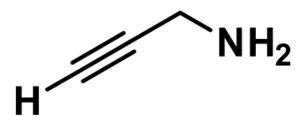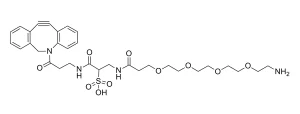Diamido-dPEG®11-diamine, product number QBD-10361, is a water-soluble, homobifunctional, single molecular weight, discrete chain length polyethylene glycol (dPEG®) crosslinker that is 49 atoms (57.1 Å) long. Both ends of the crosslinker terminate with amino groups that react with activated carboxylates or their active esters to form stable amide bonds. Aldehydes and ketones react to form labile Schiff bases that are reducible to secondary amines for improved bond stability. This molecule is useful for modifying carboxylic acid-functionalized surfaces, small molecules with reactive carbonyl groups, and carbohydrates containing reducing sugars.
The use of Diamido-dPEG®11-diamine appears in several patents. Moreover, researchers at the Karolinska Institutet, Stockholm, Sweden, reported the use of Diamido-dPEG®11-diamine in an investigation of γ-secretase and its role in Alzheimer’s Disease. Furthermore, Diamido-dPEG®11-diamine may prove useful in the following applications:
Crosslinking peptides or other small biomolecules using available carboxylic acids, aldehydes, or ketones;
Introducing a dPEG® amine onto reducing sugars of a glycoprotein’s carbohydrate coat;
Passivating nanoparticle surfaces coated with carboxylic acids or their active esters; and,
Adding a medium-length dPEG® amine at the carboxyl terminus of a peptide.
| Unit Size | 100 mg, 1000 mg |
|---|---|
| Molecular Weight | 742.94; single compound |
| Chemical formula | C₃₄H₇₀N₄O₁₃ |
| CAS | 1224728-09-9 |
| Purity | > 97% |
| Spacers | dPEG® Spacer is 49 atoms and 57.1 Å |
| Shipping | Ambient |
| Typical solubility properties (for additional information contact Customer Support) | Methylene chloride, Acetontrile, DMAC, DMSO or water. |
| Storage and handling | -20°C; Always let come to room temperature before opening; be careful to limit exposure to moisture and restore under an inert atmosphere; stock solutions can be prepared with dry solvent and kept for several days (freeze when not in use). dPEG® pegylation compounds are generally hygroscopic and should be treated as such. This will be less noticeable with liquids, but the solids will become tacky and difficult to manipulate, if care is not taken to minimize air exposure. |
Greg T. Hermanson, Bioconjugate Techniques, 3rd Edition, Elsevier, Waltham, MA 02451, 2013, ISBN 978-0-12-382239-0; See Chapter 18, Discrete PEG Reagents, pp. 787-821, for a full overview of the dPEG® products.
Visualizing Active Enzyme Complexes Using a Photoreactive Inhibitor for Proximity Ligation – Application on y-Secretase. Sophia Schedin-Weiss, Mitsuhiro Inoue, Yasuhiro Teranishi, Natsuko Goto Yamamoto, Helena Karlstrom, Bengt Winblad, Lars O. Tjernberg. PLoS ONE 2013, 8 (5) e63962. May 24, 2013. DOI:10.1371/journal.pone.0063962.
Teranishi, Y.; Hur, J.-Y.; Welander, H.; Frånberg, J.; Aoki, M.; Winblad, B.; Frykman, S.; Tjernberg, L. O. Affinity Pulldown of γ-Secretase and Associated Proteins from Human and Rat Brain. Journal of Cellular and Molecular Medicine 2010, 14 (11), 2675–2686. https://doi.org/10.1111/j.1582-4934.2009.00907.x.
Teranishi, Y. Identification and Investigation of Gamma-Secretase Associated Proteins from Brain. Doctoral Dissertation, Inst för neurobiologi, vårdvetenskap och samhälle / Dept of Neurobiology, Care Sciences and Society: Stockholm, Sweden, 2012.
Applicable patents and legal notices are available at legal notices.



Stay in the Loop. Join Our Online Community
Products
Ordering
About Us
Application
Resources

©Vector Laboratories, Inc. 2025 All Rights Reserved.
To provide the best experiences, we use technologies like cookies to store and/or access device information. Consenting to these technologies will allow us to process data such as browsing behavior or unique IDs on this site. Not consenting or withdrawing consent, may adversely affect certain features and functions. Privacy Statement
How do I Request a Quote?
To request a quote for products: